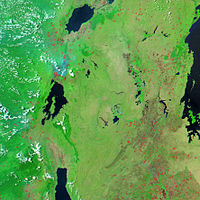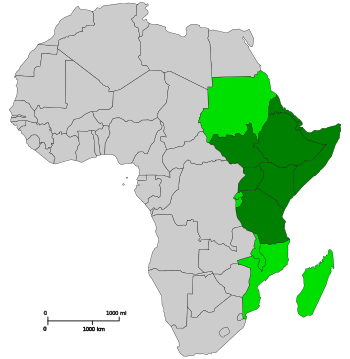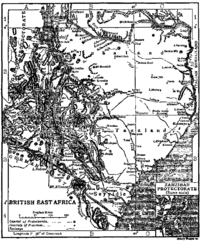
East Africa
Background Information
This content from Wikipedia has been selected by SOS Children for suitability in schools around the world. SOS mothers each look after a a family of sponsored children.
East Africa is the easternmost region of the African continent, variably defined by geography or geopolitics. It is traditionally comprised of the following countries:
- Tanzania, Kenya and Uganda – members of the East African Community (EAC). Burundi and Rwanda, fellow members of the EAC, are also sometimes included although many also consider them part a of Central Africa
- Djibouti, Eritrea, Ethiopia, and Somalia – collectively known as the Horn of Africa
Sudan is often included in this region. Madagascar is also sometimes included, but has close cultural ties to Southeast Asia and the islands of the Indian Ocean.
Geography and climate

Some parts of East Africa have been renowned for their concentrations of wild animals, such as the " big five" of elephant, buffalo, lion, leopard and black rhinoceros, though populations have been declining under increased stress in recent times, particularly the rhino and elephant.
The geography of East Africa is often stunning and scenic. Shaped by global plate tectonic forces that have created the Great Rift Valley, East Africa is the site of Kilimanjaro and Mount Kenya, the two tallest peaks in Africa. It also includes the world's second largest freshwater lake Lake Victoria, and the world's second deepest lake Lake Tanganyika.
The climate of East Africa is rather atypical of equatorial regions. Because of a combination of the region's generally high altitude and the rain shadow of the westerly monsoon winds created by the Rwenzori Mountains and Ethiopian Highlands, East Africa is surprisingly cool and dry for its latitude.
The lower-lying lands of northern Kenya and Greater Somalia are indeed extremely dry. In fact, on the coast of Somaliland and Puntland many years have no rain whatsoever. Elsewhere the annual rainfall generally increases towards the south and with altitude, being around 400 millimetres (16 in) at Mogadishu and 1,200 millimetres (47 in) at Mombasa on the coast, whilst inland it increases from around 130 millimetres (5 in) at Garoowe to over 1,100 millimetres (43 in) at Moshi near Kilimanjaro. Unusually, most of the rain falls in two distinct wet seasons, one centred around April and the other in October or November. This is usually attributed to the passage of the Intertropical Convergence Zone across the region in those months, but it may also be analogous to the autumn monsoon rains of parts of Sri Lanka, Vietnam and the Brazilian Nordeste.
West of the Rwenzoris and Ethiopian highlands the rainfall pattern is more typically tropical, with rain throughout the year near the equator and a single wet season in most of the Ethiopian Highlands from June to September - contracting to July and August around Asmara. Annual rainfall here ranges from over 1,600 millimetres (63 in) on the western slopes to around 1,250 millimetres (49 in) at Addis Ababa and 550 millimetres (22 in) at Asmara. In the high mountains rainfall can be over 2,500 millimetres (98 in).
Rainfall in East Africa is influenced by El Niño events, which tend to increase rainfall except in the northern and western parts of the Ethiopian and Eritrean highlands, where they produce drought and poor Nile floods.
Temperatures in East Africa, except on the hot and generally humid coastal belt, are moderate, with maxima of around 25 °C (77 °F) and minima of 15 °C (59 °F) at an altitude of 1,500 millimetres (5 ft). At altitudes of above 2,500 metres (8,202 ft), frosts are common during the dry season and maxima typically about 21 °C (70 °F) or less.
The unique geography and apparent suitability for farming made East Africa a target for European exploration, exploitation and colonialization in the nineteenth century. Today, tourism is an important part of the economies of Kenya, Tanzania, and Uganda.
History
Arab and Portuguese eras
The Portuguese were the first Europeans to explore the region of current-day Kenya, Tanzania, and Mozambique, Vasco da Gama having visited Mombasa in 1498. Gama's voyage was successful in reaching India and this permitted the Portuguese to trade with the Far East directly by sea, thus challenging older trading networks of mixed land and sea routes, such as the Spice trade routes that utilized the Persian Gulf, Red Sea and caravans to reach the eastern Mediterranean. The Republic of Venice had gained control over much of the trade routes between Europe and Asia. After traditional land routes to India had been closed by the Ottoman Turks, Portugal hoped to use the sea route pioneered by Gama to break the once Venetian trading monopoly. Portuguese rule in East Africa focused mainly on a coastal strip centred in Mombasa. The Portuguese presence in East Africa officially began after 1505, when flagships under the command of Don Francisco de Almeida conquered Kilwa, an island located in what is now southern Tanzania. In March 1505, having received from Manuel I the appointment of viceroy of the newly conquered territory in India, he set sail from Lisbon in command of a large and powerful fleet, and arrived in July at Quiloa ( Kilwa), which yielded to him almost without a struggle. A much more vigorous resistance was offered by the Moors of Mombasa, but the town was taken and destroyed, and its large treasures went to strengthen the resources of Almeida. Attacks followed on Hoja (now known as Ungwana, located at the mouth of the Tana River), Barawa, Angoche, Pate and other coastal towns until the western Indian Ocean was a safe haven for Portuguese commercial interests. At other places on his way, such as the island of Angediva, near Goa, and Cannanore, the Portuguese built forts, and adopted measures to secure the Portuguese supremacy. Portugal's main goal in the east coast of Africa was take control of the spice trade from the Arabs. At this stage, the Portuguese presence in East Africa served the purpose of control trade within the Indian Ocean and secure the sea routes linking Europe to Asia. Portuguese naval vessels were very disruptive to the commerce of Portugal's enemies within the western Indian Ocean and were able to demand high tariffs on items transported through the sea due to their strategic control of ports and shipping lanes. The construction of Fort Jesus in Mombasa in 1593 was meant to solidify Portuguese hegemony in the region, but their influence was clipped by the British, Dutch and Omani Arab incursions into the region during the 17th century. The Omani Arabs posed the most direct challenge to Portuguese influence in East Africa and besieged Portuguese fortresses, openly attacked naval vessels and expelled the Portuguese from the Kenyan and Tanzanian coasts by 1730. By this time the Portuguese Empire had already lost its interest on the spice trade sea route due to the decreasing profitability of that business.
Omani Arab colonization of the Kenyan and Tanzanian coasts brought the once independent city-states under closer foreign scrutiny and domination than was experienced during the Portuguese period. Like their predecessors, the Omani Arabs were primarily able only to control the coastal areas, not the interior. However, the creation of clove plantations, intensification of the slave trade and relocation of the Omani capital to Zanzibar in 1839 by Seyyid Said had the effect of consolidating the Omani power in the region. Arab governance of all the major ports along the East African coast continued until British interests aimed particularly at ending the slave trade and creation of a wage-labour system began to put pressure on Omani rule. By the late nineteenth century, the slave trade on the open seas had been completely outlawed by the British and the Omani Arabs had little ability to resist the British navy's ability to enforce the directive. The Omani presence continued in Zanzibar and Pemba until the 1964 revolution, but the official Omani Arab presence in Kenya was checked by German and British seizure of key ports and creation of crucial trade alliances with influential local leaders in the 1880s.
Period of European Imperialism
East Africa during the 19th and early 20th century became a theatre of competition between the major imperialistic European nations of the time. During the period of the Scramble for Africa, almost every country comprising present day East Africa to varying degrees became part of a European colonial empire.
Portugal had first established a strong presence in southern Mozambique and the Indian Ocean since the 15th century, while during this period their possessions increasingly grew including parts from the present northern Mozambique country, up to Mombasa in present day Kenya. At Lake Malawi, they finally met the recently created British Protectorate of Nyasaland (nowadays Malawi), which surrounded the homonymous lake on three sides, leaving the Portuguese the control of lake's eastern coast. The British Empire set foot in the region's most exploitable and promising lands acquiring what is today Uganda, and Kenya. The Protectorate of Uganda and the Colony of Kenya were located in a rich farmland area mostly appropriate for the cultivation of cash crops like coffee and tea, as well as for animal husbandry with products produced from cattle and goats, such as goat meat, beef and milk. Moreover this area had the potential for a significant residential expansion, being suitable for the relocation of a large number of British nationals to the region. Prevailing climatic conditions and the regions' geomorphology allowed the establishment of flourishing European style settlements like Nairobi and Entebbe.
The French settled the largest island of the Indian Ocean (and the fourth-largest globally), Madagascar along with a group of smaller islands nearby, namely Réunion and the Comoros. Madagascar – until then under British control – became part of the French colonial empire being ceded in exchange for the island of Zanzibar an important hub of spices trade, off the coast of Tanganyika. The British as well held a number of island colonies in the region. The Seychelles an extended archipelago and the rich farmland island of Mauritius, previously under the French sovereignty, were as such.
The German Empire gained control of a large area named German East Africa, comprising present-day Rwanda, Burundi and the mainland part of Tanzania named Tanganyika. In 1922, the British gained a League of Nations mandate over Tanganyika which it administered until Independence was granted to Tanganyika in 1961. Following the Zanzibar Revolution of 1965, the independent state of Tanganyika formed the United Republic of Tanzania by creating a union between the mainland, and the island chain of Zanzibar. Zanzibar is now a semi-autonomous state in a union with the mainland which is collectively and commonly referred to as Tanzania. German East Africa, though very extensive, was not of such strategic importance as the British Crown's colonies to the north: the inhabitation of these lands was difficult and thus limited, mainly due to climatic conditions and the local geomorphology.
Italy gained control of various parts of Somalia in the 1880s. The southern three-fourths of Somalia became an Italian protectorate ( Italian Somaliland).
Meanwhile, in 1884, a narrow coastal strip of northern Somalia came under British control ( British Somaliland). This northern protectorate was just opposite the British colony of Aden on the Arabian Peninsula. With these territories secured, Britain was able to serve as gatekeeper of the sea lane leading to British India.
In 1890, beginning with the purchase of the small port town of ( Asseb) from a local sultan in Eritrea, the Italians colonized all of Eritrea.
In 1895, from bases in Somalia and Eritrea, the Italians launched the First Italo–Ethiopian War against the Orthodox Empire of Ethiopia. By 1896, the war had become a total disaster for the Italians and Ethiopia was able to retain its independence. Ethiopia remained independent until 1936 when, after the Second Italo-Abyssinian War, it became part of Italian East Africa. The Italian occupation of Ethiopia ended in 1941 during World War II as part of the East African Campaign.
The French also staked out an East African outpost on the route to French Indochina. Starting in the 1850s, the small protectorate of Djibouti became French Somaliland in 1897.
Conflicts
Until recently most governments were illiberal and corrupt, and several countries were riven with political coups, ethnic violence and oppressive dictators. Since the end of colonialism, the region has endured:
- Ethiopian Civil War
- Eritrean War of Independence
- Eritrean-Ethiopian War
- Ogaden War
- Somali Civil War
- Second Sudanese Civil War
- Darfur Conflict in Sudan
- Burundi Civil War
- Lord's Resistance Army insurgency in Uganda
- Rwandan Genocide
Kenya and Tanzania have enjoyed relatively stable governments. However politics has been turbulent at times, including the attempted coup d’état in 1982 and the 2007 election riots in Kenya.
Djibouti and the Puntland and Somaliland regions of Somalia have also seen relative stability.
Tanzania has known stable government since independence although there are significant political and religious tensions resulting from the political union between Tanganyika and Zanzibar in 1964. Zanzibar is now a semi-autonomous state in the United Republic of Tanzania. Tanzania and Uganda fought the Uganda-Tanzania War in 1978–1979, which led to the removal of Uganda's despotic leader Idi Amin.



